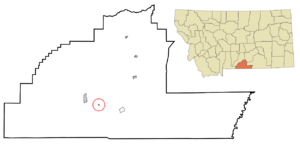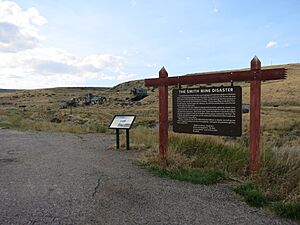Bearcreek, Montana facts for kids
Quick facts for kids
Bearcreek, Montana
|
|
|---|---|
|
Incorporated town
|
|

Location of Bearcreek, Montana
|
|
| Country | United States |
| State | Montana |
| County | Carbon |
| Area | |
| • Total | 0.11 sq mi (0.30 km2) |
| • Land | 0.11 sq mi (0.30 km2) |
| • Water | 0.00 sq mi (0.00 km2) |
| Elevation | 4,551 ft (1,387 m) |
| Population
(2020)
|
|
| • Total | 91 |
| • Density | 798.25/sq mi (307.14/km2) |
| Time zone | UTC-7 (Mountain (MST)) |
| • Summer (DST) | UTC-6 (MDT) |
| ZIP code |
59007
|
| Area code(s) | 406 |
| FIPS code | 30-04300 |
| GNIS feature ID | 2411671 |
Bearcreek is a small, officially recognized town in Carbon County, Montana, United States. It is part of the larger Billings area. In 2020, 91 people lived there. Bearcreek is run by a Mayor and a Council.
Discovering Bearcreek's Past
Bearcreek exists because of coal mining that started in the 1890s. The mines supplied coal to the Northern Pacific Railway and the Anaconda Company. The Bearcreek Post Office opened on November 22, 1905. Sarah Criger was the first postmaster. The town was planned and officially formed after the Montana, Wyoming & Southern Railroad arrived in 1906.
Bearcreek got its name from Bear Creek, which flows through the town. The town grew quickly after a short railroad line connected its mines to the Northern Pacific Railroad in 1906. From 1906 to 1953, the mines in Bearcreek produced a lot of high-quality coal. This coal came from large underground deposits. The mines were along the creek and in nearby valleys.
Miners Arrive and Communities Grow
After 1906, many miners moved to Bearcreek. They came from other parts of America and from countries like Serbia, Montenegro, Germany, Scotland, and Italy. These new immigrants built separate communities in the steep valleys around Bearcreek. These places had names like Washoe, New Caledonia, Chickentown, Scotch Coulee, International, and Stringtown.
In the 1920s and 1930s, Bearcreek and its nearby communities had about 3,000 people. The town had seven stores, a bank, two hotels, two billiard halls, a brickyard, and many saloons. Bearcreek even had concrete sidewalks and its own water system. It is said that the town had no churches. The town's economy was based on coal.
The Smith Mine Disaster and Decline
A terrible event called the Smith Mine Disaster happened in 1943. After this, people started using less coal in the late 1940s and 1950s. This caused the connecting railroad to close in 1953. Most of the coal mines then closed too. The town's population steadily dropped to less than 100 people. Many buildings were moved or torn down, and only a few remain today.
Fun in Bearcreek Today
Today, Bearcreek is home to the Bearcreek Saloon. This place hosts fun pig races to raise money throughout the year. Also, every autumn, Bearcreek hosts the Montana Falconer Symposium. This is the state's largest meeting for falcon trainers and bird of prey fans.
A law was even passed in Montana about betting on pig races. It states that races between pigs, gerbils, or hamsters can happen in certain places. These races must be held outside the main eating and drinking areas.
Bearcreek was also featured in the TV show Strange New Worlds. In the first episode of Season 1, it was shown as the home of Captain Christopher Pike.
The Montana, Wyoming & Southern Railroad's Role
The Montana, Wyoming and Southern (MW&S) was a special railroad line built in 1906. It ran 21 miles from the main Northern Pacific Railroad (NP) line at Bridger, Montana through Belfry to the mines in Bearcreek. All the coal from Bearcreek's mines traveled on this line.
The MW&S was built by people hoping to sell it to the NP. The NP used the high-quality coal from Bearcreek for its engines. However, the NP did not buy the MW&S. Instead, it tried to control it through business deals. The MW&S had to operate on its own and often faced money problems from the NP. Even though it shipped a lot of coal, it struggled. The mine owners in Bearcreek depended completely on the MW&S to move their coal. The MW&S was a weak but very important link for Bearcreek's success.
Workers from Near and Far
After the MW&S railroad was built, Bearcreek grew quickly as coal production increased. Workers from America and other countries moved there. They were drawn by the growing coal mining and the promise of steady jobs. By 1917, the mines around Bearcreek employed 1,200 men.
As the miners arrived, they settled in small communities in the valleys around Bear Creek. At its busiest, Bearcreek and its surrounding communities had about 3,000 people. Most of them worked in the coal mines.
From 1906 onwards, many Serbian/Slavic immigrants from Serbia and Montenegro came to Bearcreek. These families brought their culture and traditions. Because of its many different cultures, Bearcreek traditionally celebrated Christmas twice. Once on December 25th and again on January 6th, which is the Serbian Orthodox Church holiday.
The Smith Mine Disaster's Impact
On February 27, 1943, the Smith Mine #3 exploded. This was the worst coal mining accident in Montana's history. Out of 77 men who went underground that day, only 3 survived.
Thirty men died right away. Forty-four miners survived the first blast but were trapped underground. They died from injuries or from breathing in poisonous gases like methane and carbon monoxide. Some even left goodbye notes for their families. The Smith Mine never reopened. This disaster greatly hurt the community.
Life After the Mines Closed
In the late 1940s and early 1950s, people in America started using less coal. They began using natural gas or fuel oil for heating. Also, trains started using diesel instead of coal. This caused Bearcreek's coal production to steadily drop.
After the Smith Mine closed and coal demand fell, the Montana, Wyoming and Southern railroad also struggled. It stopped running in 1953. When the railroad closed, most of the mining in Bearcreek stopped too. The railroad was the only good way to ship coal to market. Some mines kept going, but the last one closed in the 1970s.
After the railroad and most mines closed, the town's population quickly shrank. It eventually went below 100 people. The railroad tracks were removed. Over time, the many empty miners' houses were sold and moved, or they fell apart and were torn down.
Today, most of the communities that made up Bearcreek are gone. Only a few houses mark Washoe, which is now the largest of them. In recent years, the tiny community of Bearcreek has seen some growth. This is because it is close to Red Lodge. Red Lodge has an economy that serves tourists who come to ski, use summer cabins, or visit Yellowstone Park.
Bearcreek's Location
Bearcreek is located on Montana Secondary Highway 308. It is about halfway between Red Lodge and Belfry.
The town covers an area of about 0.12 square miles (0.30 square kilometers), all of which is land.
People of Bearcreek
| Historical population | |||
|---|---|---|---|
| Census | Pop. | %± | |
| 1910 | 302 | — | |
| 1920 | 744 | 146.4% | |
| 1930 | 472 | −36.6% | |
| 1940 | 324 | −31.4% | |
| 1950 | 162 | −50.0% | |
| 1960 | 61 | −62.3% | |
| 1970 | 31 | −49.2% | |
| 1980 | 61 | 96.8% | |
| 1990 | 37 | −39.3% | |
| 2000 | 83 | 124.3% | |
| 2010 | 79 | −4.8% | |
| 2020 | 91 | 15.2% | |
| U.S. Decennial Census | |||
Bearcreek in 2010
In 2010, there were 79 people living in Bearcreek. They lived in 44 households, and 20 of these were families. The town had about 658 people per square mile. There were 51 homes, with about 425 homes per square mile. Most of the people (98.7%) were White. A small number (1.3%) were from two or more races.
Out of the 44 households, 15.9% had children under 18 living with them. 40.9% were married couples. The average household had 1.80 people, and the average family had 2.50 people.
The average age in Bearcreek was 53.5 years old. About 13.9% of residents were under 18. 27.8% were 65 years or older. The town had slightly more females (50.6%) than males (49.4%).
See also
 In Spanish: Bearcreek (Montana) para niños
In Spanish: Bearcreek (Montana) para niños


